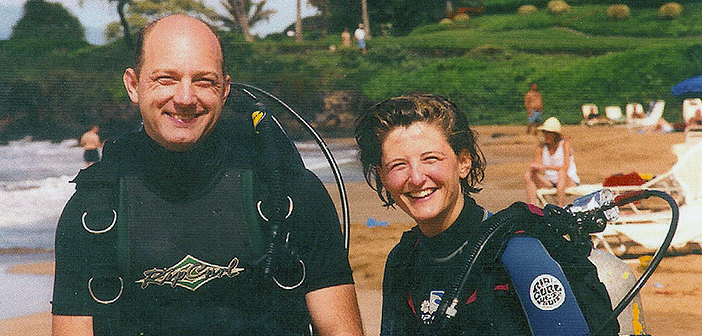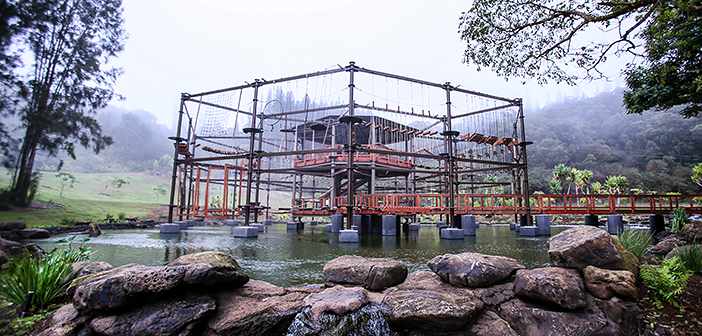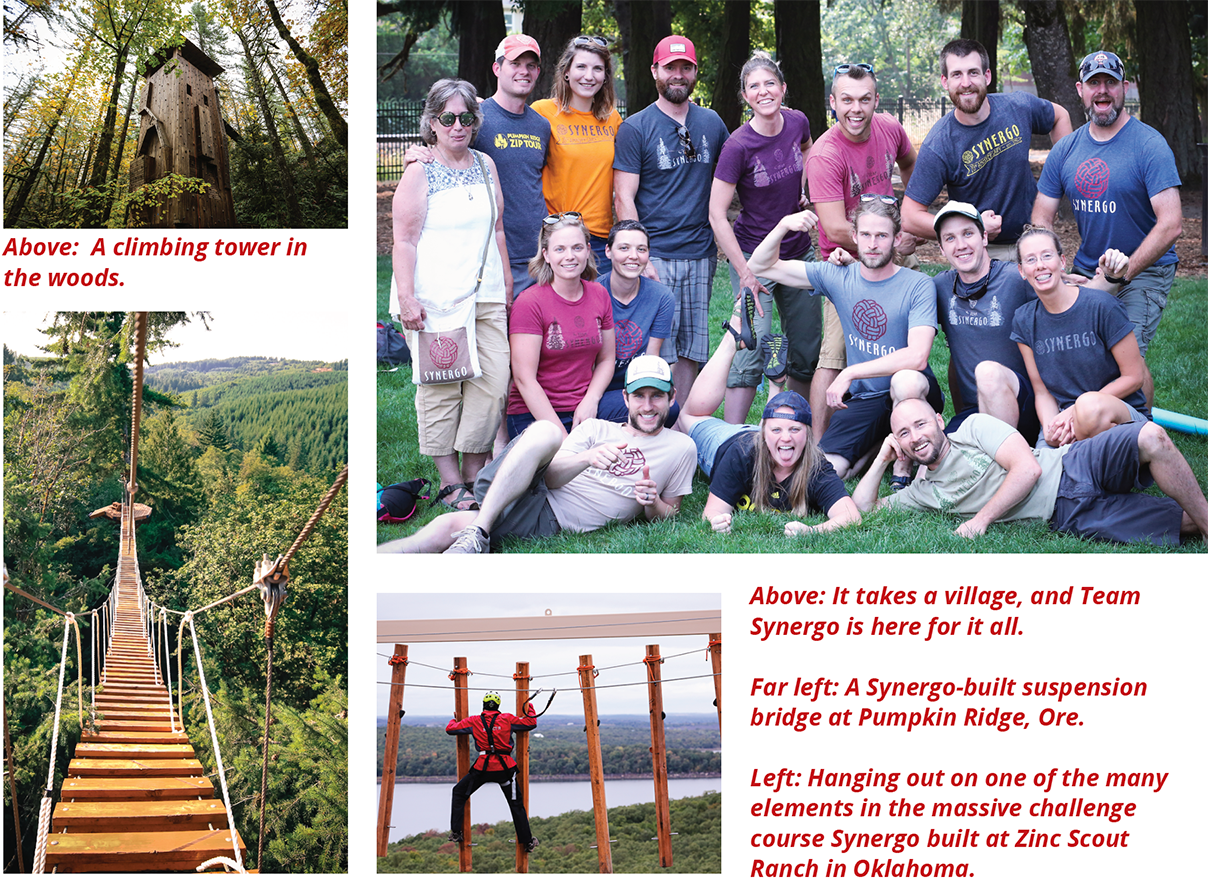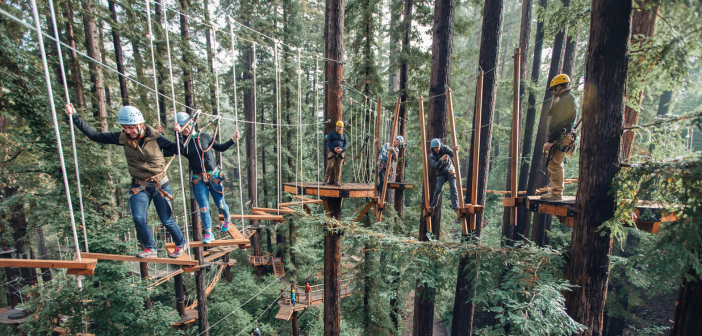From a modest start building and repairing challenge courses for local nonprofits and camps in the Portland, Ore., area in the 1990s, Synergo has grown into a multifaceted leader in adventure course design, construction, management, training, and equipment supply. Signature projects include adventure parks in redwood forests, a Hawaiian quarry, and a Montana dude ranch.
API recently sat down with Synergo owners Erik and Jennifer Marter to discuss the rewards and challenges of operating as a husband-and-wife team, the company’s core competencies and guiding philosophy, and why the biggest challenge facing the adventure park industry isn’t necessarily technology or safety but recruiting passionate people.


Synergo founders and owners Erik and Jennifer Marter now (top) and in the early days (bottom).
API: Synergo was founded in 1994, so you are coming up on its 30th anniversary. Can you tell us a bit about how you got started in the industry and how the company was formed?
Erik: I was running a Northwest Youth Corps program and was kind of in between things. A local school I went to for kindergarten through fourth grade called me up and said, “we have this ropes course on our property, and we want it fixed up. We don’t really have any money for it, but we can let you use it for other programs.” And I thought, “I can do that.” A few other sites around the region heard about what I was doing and asked if I could work on their courses, too. I loved it.
Over time, I worked with bigger programs and built larger courses. It was like a snowball going downhill that I just couldn’t get out of the way of. I would build all day, then come home exhausted at night and write emails and send proposals and bids. I had a hard time transitioning, and Jennifer said, “let me help out.”
Jennifer: I had a long history of working for the YMCA. I grew up working at summer camps and at my local Y. When I moved to Portland, I went to the YMCA and worked part-time until I saw a job posting for program director, and I got that job. Part of my responsibility was to coordinate with Erik, who was the contractor building the climbing wall for the new facility that we were opening. That’s how we met.
Over time, seeing his workload, I started to help manage the business in my “spare time.” A couple years later, around the time that we got married, I said, “we might be able to support both of us on this.” We had some dedicated camps that wanted help with their programming. So, they contracted that out to us, which allowed us to bring in larger programs and spread the word.
Erik: And it was great—like, holy smokes. When Jennifer came on in the beginning, it was a scary time. We got baseball hats, which sounds a little weird, but you only buy baseball hats when you’re successful, right? So, we got hats that said, “Team Synergo” on them. I still have some of the originals.
API: You’ve come a long way since then. Jennifer, you talked about taking on programming aspects for some of your clients, and obviously, you build, provide training and inspection, and equipment supply. There are a lot of arms of the company now—is there a particular aspect that you consider your core competency?
Jennifer: That’s a hard question, because I think it depends on from what perspective you’re looking at it. Covid really hit the programming side of our business hard, but we would never give it up. It’s so much a part of our mission, and so much a part of why we started this company.
Our construction department has grown from just building some camp challenge course elements to now these bridges and big zip line tours and adventure parks and towers. I would say that’s one of the things we’re known for and that we highlight. Training is also something we’re known for and are passionate about.
Erik: We still get to play with the programs, we just do it differently now. The programming for us is about helping people change their lives and challenge themselves with this idea of adventure.
I grew up very experientially. I would go outside and climb things and crawl over things and through things—and I thought, this is life. So, when we can support a camp that’s got 1,000 kids during the summer doing really cool programs, that’s neat for us. This isn’t about stunts; this isn’t about overcoming your fear. This is about learning to dance with your fear, play around at height, and have an experience with your family or with other people, and grow together because of that.

The Aerial Adventure Tower at Hawaii’s Lanai Adventure Park offers two tiers of intersecting bridges, elements, and obstacles—in the middle of a lake.
API: Sounds like you’re bridging some of those traditional facilitation elements with the commercial side of running a camp or running a zip tour.
Erik: Yeah. Your question is, “What are we great at?” I think it’s holding it all together. We were building bridges in California where the clients said, “we’ve talked to four vendors, and no one will touch this. No one can figure out how to do it.” As we are designing that project and figuring the whole thing out, the concept we kept coming back to is how do we let the experience unfold in front of people? As you go up a hundred feet into redwood trees, how do we move people slowly through that and have the story unfold so that when they are on a bridge that moves just a little bit and they’re looking down a hundred feet, they’re not petrified. That philosophy and that design goes into everything we do.
If I could get the whole industry doing that, I think we would all be better. You can’t just keep going longer and longer, higher and higher, and faster and faster. There must be limits to it. Jennifer and I built a tour up in the San Juan Islands years ago. It was very small—a zip line tour in the woods with swamps and bushes and trees and stuff. And we would get this feedback from people who said, “I’ve been zip lining all over the country and this is really good: these lines are not long, they’re not fast, they’re not high, but they have the best guides that we’ve ever seen.” And that’s the kind of feedback we love to hear.
API: You are not interested in the superlatives. So, when you think about the projects that you’ve worked on, or when you’re eyeing a new project, what motivates or excites you?
Jennifer: Anytime there’s something that’s going to challenge us, we’re interested, because that’s what we’re all about. If it’s something just a little outside of our comfort zone, we want to see what we can do with it. At the same time, it’s more about learning from a client how this thing will be used and what the guests will feel while they’re using it and after they go home. It’s got to fit our mission of people having these life-changing experiences and learning about themselves and learning about their community or learning about their family or having an experience together.
Erik: What we’re looking for is passion. Some camps just need a ropes course built so that they can make some more money. Others have leaders who say, “a challenge course saved my life as a kid and I’m a new human because of it, and we want one in our camp.” That’s the stuff that gets our company fired up; the passion that our clients bring stimulates our staff.
We also like new creative things, especially Zeke [Caldwell], our construction manager. He loves to push the boundaries in what we design. Our project on the island of Lanai includes a giant steel adventure tower. There’s a bunch of adventure parks around, right? But this one’s different. It looks different, and it’s in the middle of a lake. We’ve had local kids and adults and some of the world’s most famous people on it, and they all love it. We get to design that stuff. We love that.
We’ve also been designing new activities that are a cross between an outdoor physical activity, such as a playground, and a traditional challenge course, where you’re not just balancing on things, you’re not wearing a harness, and you don’t need spotters. Some similar activities have already been introduced in our industry. But now, we’re taking those and creating a group experience where you can just go up, read some instructions or a storyline, and say, “hey group, here’s what we gotta do.”

API: Erik, you’ve been involved in the Mount Hood Kiwanis Camp—an outdoor recreational camp for individuals living with disabilities—for years. Does that have any influence on Synergo’s mission?
Erik: I started working there back in the ’80s, and I chair the board now. It’s the camp I grew up at, and my mom was the director of camp for a while.
I went to a small private school for a while with very similar human beings. They all looked the same. They all sounded the same. They all had similar parents who all had professional jobs. Then my summers were spent at the Kiwanis Camp, where nobody was the same: every human being at that camp, you have to work with them differently. When we take people who live with disabilities and we put them on the ropes course, everybody gets put on in their own way. That mentality of figuring out how to customize challenge courses or zip line tools or anything for each person instead of all people remains one of the underlying principles of our business.
API: What’s it like to work as a husband-and-wife team?
Jennifer: It’s certainly not without challenges, but I feel like we learn so much about ourselves and each other through work. Earlier on, we kind of stayed out of each other’s way in terms of what we were responsible for. I was running the day-to-day business, working with clients, communicating about program scheduling. Erik was mostly handling instruction, and he would go out and do the programs. Now, it’s a bit more overlapping. We have such great staff who are directors of our departments, and now our job is supporting them, guiding them, and growing the business.
Erik: It’s super cool, because work is our thing to do together, and we love growing it and stressing about it. As we work, travel, solve problems, and grow the company, we are building memories together. When we are old and slow, sitting on the front porch of our assisted living facility drinking whiskey and recounting our lives, we will have many of the same memories to rehash, relive, enjoy together.
API: As you approach the 30-year anniversary of the company, what do you see for the future of the industry in general, and what’s ahead for Synergo?
Erik: When we built our first zip tour, I was like, “this will last a couple years and people will get tired of it.” Now, they’re running hundreds and hundreds of people a day, and it’s still on people’s bucket lists. I go to summer camps and people are still climbing up rock walls, and we’re still building them and we’re still putting challenge courses in camps. And we still want and need them, because people still need to learn how to get out of their comfort zone. People still need to learn how to dance with their fear instead of letting fear overwhelm them—after Covid more than ever.
I think the industry has some great opportunities, but we are all challenged right now with finding people who want to be facilitators, who want to spend three weeks in Hawaii building cool things, who want to go dangle in some giant trees in Alaska for four weeks and set up cool stuff. The challenge coming up is getting people to build and create.
One of the things we’ve been really good at, and we’re consciously thinking about, is how to build this company so that when we leave and get out of its way, it keeps going.

Clockwise, starting above: Synergo built the Redwood Sky Walk in California, which was voted as “Best Aerial Adventure Park” in 2023 by readers of USA Today; The adventure camp at Mount Hermon, Calif., introduces guests to the climates and ecosystems unique to the redwoods; Building in big trees.
Jennifer: About 20 years ago, we had someone ask us about our exit plan. We couldn’t even think through the next week, let alone what we wanted this company to look like when we’re ready to leave. Now, we have this group of people at ACCT we have connected with for 25 years or more, and it’s nice to see people that have successfully navigated the exit plan and to have some mentors. It’s not that we’re ever going to step out of the business completely, but it’s important to both of us that it continues long after we have full-time energy for it. We have a fantastic team, and that’s the thing that keeps us going.
Erik: When I started Synergo in 1994, it was an in-between thing—I’ll go run ropes courses and I’ll go do team-building until I get my real job and figure out what I want to be if I grow up. I never figured it out, but I knew very young that while I was in pretty good shape, I wouldn’t be able to do this (the physical side of building and training) when I was 60 years old. So, we started building the infrastructure for other people to come in. It’s not like having kids, but it’s like having a family—all these people have good ways of thinking and being.
Jennifer: It takes incredible partners, incredible staff, other people who understand the vision and the mission and want to be a part of it. It takes all of us together working on it, not just the two of us.






